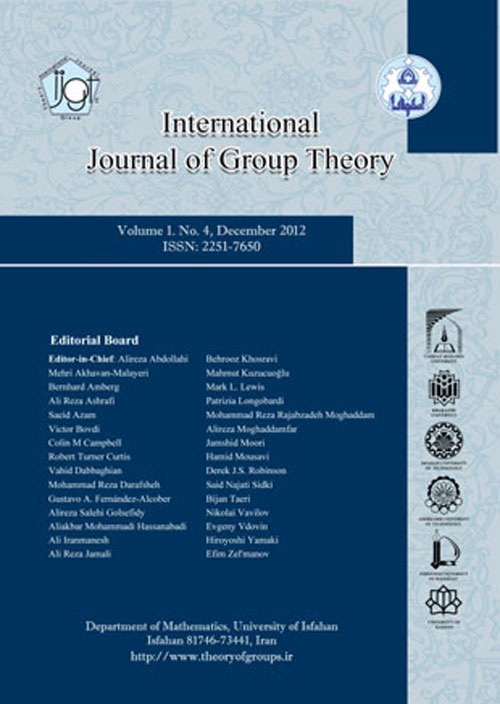فهرست مطالب

International Journal of Group Theory
Volume:10 Issue: 3, Sep 2021
- تاریخ انتشار: 1399/10/27
- تعداد عناوین: 5
-
-
Pages 97-101
In 2017 Deveci et al. defined the Fibonacci-circulant sequences of the first and second kinds as shown, respectively:x_n^1 = -x_(n-1)^1+x_(n-2)^1-x_(n-3)^1 for n≥4,where x_1^1=x_2^1=0 and x_3^1=1andx_n^2 = -x_(n-3)^2-x_(n-4)^2+x_(n-5)^2 for n≥6,where x_1^2=x_2^2=x_3^2=x_4^2=0 and x_5^2=1Also, they extended the Fibonacci-circulant sequences of the first and second kinds to groups. In this paper, we obtain the periods of the Fibonacci-circulant sequences of the first and second kinds in the binary polyhedral groups.
* The formulas are not displayed correctly.Keywords: The Fibonacci-circulant sequences, Period, group -
Pages 103-124
Let $G$ be a group. For an element $ain G$, denote by $cs(a)$ the second centralizer of~$a$ in~$G$, which is the set of all elements $bin G$ such that $bx=xb$ for every $xin G$ that commutes with $a$. Let $M$ be any maximal abelian subgroup of $G$. Then $cs(a)subseteq M$ for every $ain M$. The emph{abelian rank} (emph{$a$-rank}) of $M$ is the minimum cardinality of a set $Asubseteq M$ such that $bigcup_{ain A}cs(a)$ generates $M$. Denote by $S_n$ the symmetric group of permutations on the set $X={1,ldots,n}$. The aim of this paper is to determine the maximal abelian subgroups of $gx$ of $cor$~$1$ and describe a class of maximal abelian subgroups of $gx$ of $cor$ at most~$2$.
* The formulas are not displayed correctly.Keywords: Symmetric groups, maximal abelian subgroups, second centralizers, abelian rank -
Pages 125-135
A finite group $G$, in which two randomly chosen subgroups $H$ and $K$ commute, has been classified by Iwasawa in 1941. It is possible to define a probabilistic notion, which ``measures the distance'' of $G$ from the groups of Iwasawa. Here we introduce the generalized subgroup commutativity degree $gsd(G)$ for two arbitrary sublattices $mathrm{S}(G)$ and $mathrm{T}(G)$ of the lattice of subgroups $mathrm{L}(G)$ of $G$. Upper and lower bounds for $gsd(G)$ are shown and we study the behaviour of $gsd(G)$ with respect to subgroups and quotients, showing new numerical restrictions.
* The formulas are not displayed correctly.Keywords: Subgroup commutativity degree, Dihedral groups, Sublattices, Elementary abelian $p$-groups, polynomial functions -
Pages 137-147
There are many different graphs one can associate to a group. Some examples are the well-known Cayley graph, the zero divisor graph (of a ring), the power graph, and the recently introduced coprime graph of a group. The coprime graph of a group $G$, denoted $Gamma_G$, is the graph whose vertices are the group elements with $g$ adjacent to $h$ if and only if $(o(g),o(h))=1$. In this paper we calculate the independence number of the coprime graph of the dihedral groups. Additionally, we characterize the groups whose coprime graph is perfect.
* The formulas are not displayed correctly.Keywords: coprime graph, Finite groups, Independence number, perfect graph -
Pages 149-157
We record for reference a detailed description of the automorphism groups of the groups of order $p^{2}q$, where $p$ and $q$ are distinct primes.
* The formulas are not displayed correctly.Keywords: Automorphisms, groups of small order, Finite groups

